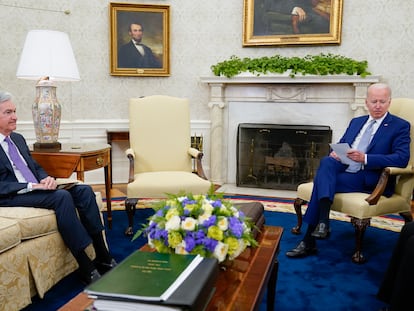US economy slows in election year with growth of just 1.3% in first quarter
The slowdown is bad news for U.S. President Joe Biden, who is seeking re-election in November. The Commerce Department had previously estimated that the nation’s GDP expanded at a 1.6%


The U.S. economy is losing steam in the middle of an election year. After strong growth that exceeded all expectations in 2023, the world’s leading economy cooled in the first quarter of this year. The slowdown was somewhat greater than anticipated in the first estimate, and gross domestic product (GDP) grew at an annual rate of 1.3% in the first quarter, 0.3% lower than initially expected, according to data released Thursday by the Commerce Department’s Bureau of Economic Analysis.
Economists had expected that the 1.6% growth rate forecast in the preliminary first-quarter estimate would be revised downward. It represents a slowdown from the 3.4% annual rate in the fourth quarter of 2023. The figure has yet to be revised a second time.
“The increase in real GDP primarily reflected increases in consumer spending, residential fixed investment, nonresidential fixed investment, and state and local government spending that were partly offset by a decrease in private inventory investment. Imports, which are a subtraction in the calculation of GDP, increased,” the Bureau of Economic Analysis explained.
The downgrade is bad news for U.S. President Joe Biden, who is seeking re-election in the November presidential election. With inflation still not budging, Biden is trying to counter the concern over consumer prices by pointing to job creation and GDP growth. Even so, the fact that part of the slowdown is due to private inventory investment and the foreign sector relativizes the worsening growth data.
In fact, disposable personal income increased $266.7 billion, or 5.3%, in the first quarter, an upward revision of $40.5 billion from the previous estimate. Real disposable personal income increased at a 1.9% annualized quarterly rate, an upward revision of 0.8 percentage points.
The Fed said Wednesday that growth continued in the first half of the second quarter, but noted that it had detected signs of increased pessimism “amid reports of rising uncertainty and greater downside risks.”
The U.S. is seeing the highest interest rates in 23 years, and this is taking a toll on growth. Still, Fed Chair Jerome Powell warned that he will not start lowering rates until the central bank has greater confidence that inflation is sustainably headed toward the 2% price stability target.
Although Powell believes there will be no further rate hikes, the current level is holding longer than initially thought, and it is unclear when the first rate cut will come. Investors and analysts are waiting for clues from the members of the Federal Open Market Committee (FOMC) of the Federal Reserve after their meeting on June 12. At this meeting, they are due to update their forecasts on the appropriate monetary policy to follow. The March forecasts, which still pointed to three 0.25-point cuts by the end of the year, now hold no meaning, and investors believe that there will be one or at most two rate cuts by December.
Compared to the fourth quarter, the slowdown in GDP in the first quarter mainly reflected slowdowns in consumer spending, exports and state and local government spending, as well as a decline in federal government spending. These moves were partly offset by an acceleration in residential fixed investment. Imports accelerated.
Sign up for our weekly newsletter to get more English-language news coverage from EL PAÍS USA Edition
Tu suscripción se está usando en otro dispositivo
¿Quieres añadir otro usuario a tu suscripción?
Si continúas leyendo en este dispositivo, no se podrá leer en el otro.
FlechaTu suscripción se está usando en otro dispositivo y solo puedes acceder a EL PAÍS desde un dispositivo a la vez.
Si quieres compartir tu cuenta, cambia tu suscripción a la modalidad Premium, así podrás añadir otro usuario. Cada uno accederá con su propia cuenta de email, lo que os permitirá personalizar vuestra experiencia en EL PAÍS.
¿Tienes una suscripción de empresa? Accede aquí para contratar más cuentas.
En el caso de no saber quién está usando tu cuenta, te recomendamos cambiar tu contraseña aquí.
Si decides continuar compartiendo tu cuenta, este mensaje se mostrará en tu dispositivo y en el de la otra persona que está usando tu cuenta de forma indefinida, afectando a tu experiencia de lectura. Puedes consultar aquí los términos y condiciones de la suscripción digital.
More information
Archived In
Últimas noticias
Welcome to the post-religion era: The idea of Christianity as the absolute truth has become obsolete
‘I thought you would like it’: The risky sexual practice popularized by TV shows and TikTok
The digitalization of tourism: ‘They promise experiences and gave us the worst possible one’
Mexican peso defies uncertainty with forecasts of a new period of stability in 2026
Most viewed
- Sinaloa Cartel war is taking its toll on Los Chapitos
- Oona Chaplin: ‘I told James Cameron that I was living in a treehouse and starting a permaculture project with a friend’
- Reinhard Genzel, Nobel laureate in physics: ‘One-minute videos will never give you the truth’
- Why the price of coffee has skyrocketed: from Brazilian plantations to specialty coffee houses
- Silver prices are going crazy: This is what’s fueling the rally










































